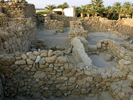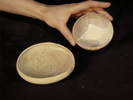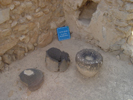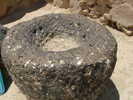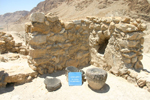Kitchen

Introduction
Along the northern side of the central courtyard of the “main building,” there is a room that has been identified as a kitchen, as it contained three ovens, a paved area with signs of burning, and a mud-brick platform. It is unclear whether the room served this purpose prior to the earthquake of 31 BCE. The staircase associated with the kitchen was constructed with two adjacent passages, which seems to reflect the Community’s concern with purity. The configuration calls to mind the divided staircases found in several of the ancient miqva’ot, ritual baths, found at Qumran and Jerusalem.
It seems likely that there was at lease one additional food preparation/dining area in the Qumran complex. Ovens and caches of pottery found in the secondary building lead Jodi Magness to suggest that an additional dining area was located there, perhaps on a second floor above the remains of several smaller rooms (the remains of a staircase have been found in the secondary building). This food preparation and dining area may have come into use following the earthquake that damaged the main building in 31 B.C.E., and been used until the site was abandoned for a time beginning in ca. 9/8 B.C.E. It is also quite possible, says Magness, that both kitchen / dining areas were in use during the final phase of the site’s occupation, that is, the first century C.E.
Dietary laws (“kashrut”) were a significant component of ancient Jewish life. Certain animals are prohibited for food in the Torah; in addition, regulations about preparing and consuming milk and meat, about how animals were slaughtered, and about how crops were harvested and tithed affected the kosher status of different foods. CD 12:11–14, for example, expands upon the dietary laws found in Leviticus, prescribing that fish (as well as meat) must be “opened up alive and their blood poured away” in order to be permissible for consumption. Tithing involved identifying the portions of various crops which were to be set aside for the priests and the poor. Fragments of the Damascus Document from Cave 4 include elaboration of biblical procedures for properly harvesting and tithing grapes and other crops.
The Qumran community was particularly scrupulous about matters of purity pertaining to food. Impurity could be communicated by touch, and could derive from contact with a variety of things—non-kosher animals, bodily fluids, dead bodies, for example. The sectarians took particular care to protect their food and drink from inadvertent contamination.
For instance, the Community Rule stipulates that members were required to immerse in a ritual bath before each communal meal (See 4Q514; 4Q274). One of the most striking examples of the sect’s concentration on food purity can be seen in the laws set forth for community membership. Even after passing a rigorous entrance examination, a new member could not touch the pure meal of the Congregation until a full year was completed and his spiritual deeds were reexamined. At the end of this probationary period, a qualified candidate was still required to refrain from the pure drink of the Many; only after a second year when he was considered a full-fledged member with respect to tahorah (purity) was he considered worthy and allowed to taste the pure drink of the Many. See admission to the community. The sect further differentiated between the food of the laymen and that of the priests. The former was referred to as tahorot ha-Rabbim or “the pure food of the Many.” The priest’s food was termed tahorot ha-qodesh or “sacred pure food.” (See 1QS VI 16-17, 25 and 1QS V 13; VIII 17). See also Ritual Purity.
A variety of animal bones have been found in pottery containers at Qumran. Most of these bone deposits have been found outside the buildings of the site, but close to the areas where meals were probably consumed: the Assembly hall and Pantry of the main building, and the food preparation/ dining area of the secondary building. These animal deposits were not whole skeletons, but separate bones, many of them broken, which had been cleaned of flesh. Some of the bones have burn marks, indicating they were cooked. It thus appears that meat was another component of the sectarian diet, most likely at communal meals which had a special ritual significance, such as the annual festival of Renewal of the Covenant (1QS 1–3:11), which might have been held at the site. This conclusion is supported by the fact that the bones found are those of animals which meet biblical dietary requirements, including sheep, goats and oxen. The literary evidence from the scrolls, and the fact that no remains of any altar have been found at Qumran, indicate that sacrifices were not offered at Qumran, but rather that the community observed certain rituals associated with the consumption of meat. It is likely that these rituals developed by analogy to the treatment of sacrificial meat in the Temple. The Qumranites seem to have seen the meat and its remains as possessing a certain degree of holiness, and disposed of the remains in a manner similar to that followed in the Temple.
More Info
- Jodi Magness, “Archaeological Evidence for Communal Meals at Qumran,” in The Archaeology of Qumran and the Dead Sea Scrolls (Grand Rapids; Eerdmans, 2002), 116–126.
- Randall Price, “New Discoveries at Qumran,” World of the Bible News and Views 6/3 (Fall, 2004):1–4 http://www.worldofthebible.com/Documents/SpecialOnlineReport.pdf
